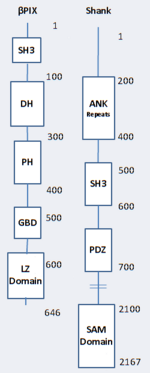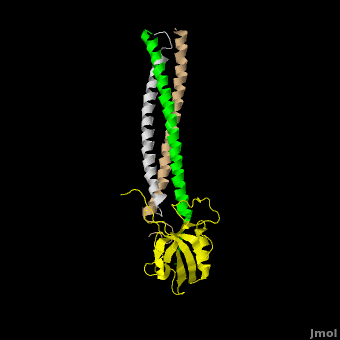Shank protein
From Proteopedia
Chromosome 22q13 Deletion SyndromeChromosome 22q13 deletion syndrome (22q13DS) is a neurobehavioral syndrome marked by global developmental delay, and autism spectrum disorder (ASD) features.[3] The Shank-3 gene is located within this region of chromosome 22. Studies have revealed that point mutations in Shank-3 can cause the neurodevelopmental symptoms associated with 22q13DS, accounting for 1% of all autism cases.[8] At the molecular level, disruption of the full length Shank-3 protein reduces AMPA receptor signaling and spine remodeling.[4]Mice who were haploinsufficient for Shank-3, emitted fewer ultrasonic vocalizations during interactions with estrus female mice, a behavior reminiscent of that seen in Autism patients. Further, Shank knockout mice have less dendritic spine development, a diminished PSD size, decreased levels of proteins GKAP and Homer, and greatly impaired synaptic signaling. Interestingly, overexpression of Shank-3 may also result in an ASD, supporting the hypothesis that Autism is caused by improper Excitatory/Inhibitory neuronal ratios in the brain.[4] Measurements of broad miRNA expression levels in Autism patients uncovered aberrant levels of miRNAs for genes involved in ASDs like MeCP2, the cause of Rett Syndrome, NRXN-1, a gene implicated in ASDs, and Shank-3, adding support to Shank-3’s role in autism.[9] Due to the marked reduction in AMPA receptor signalling in Shank-3 mutants, compounds that enhance AMPA transmission (AMPAkinses) serve as potential therapeutic approaches to treating some ASDs.[4] βPIX StructureβPIX is a protein belonging to a group of guanine nucleotide exchange factors used by Rho GTPase family members, like Rac1 and Cdc42. Rac1 and Cdc42 regulate the actin cytoskeleton of synapses.[10] PIX has an N-terminal Src homology 3 (SH3) domain which associates with PAK, a coiled-coil (CC) domain, which is critical for multimerization, and a C-terminal PDZ binding domain which interacts with the PDZ domain of Shank.[10] The interaction of Shank with βPIX promotes the synaptic localization of βPIX and βPIX associated p21 Associated Kinase (PAK). Since PAK regulates actin cytoskeletons, and dendritic spines are actin-rich structures, it is believed that Shank recruits βPIX to dendritic spines to regulate the PSD.[1] Shank Family Protein StructureThe canonical PDZ domain contains 90 amino acids and folds into a compact globular structure consisting of a six-stranded β-sandwich flanked by two alpha helices.[10] βPIX possess a parallel trimer via helical hydrophobic interactions within its CC domain, a proline to break the helix, and a PDZ binding domain at the C-terminus. Interestingly, only 1 Shank molecule is bound to the CC domain trimer of βPIX in an asymettric assembly. The 8-residue PDZ binding domain of βPIX forms a number of hydrogen bonding and hydrophobic interactions with the Shank PDZ domain. Shank-3-Arg 679 forms the most critical interaction with βPIX, tightly H-Bonding Glutamate 643, forming 2 weak bonds with Phe 696, and Van der Waals interactions with ring of Phe 696. Abolishing this interaction through mutagenesis completely eliminates the assembly. Upon binding of βPIX, the PDZ domain undergoes a significant conformational change. Lys 682 undergoes a nearly 11 Angstrom displacement to make room for the βPIX PDZ binding domain.[10] Shank OligomerizationShank proteins are positioned between scaffolding proteins that are bound to either neurotransmitter receptors or the actin cytoskeleton. This puts Shank proteins in a perfect position to create the underlying structure of the PSD.[2] The SAM domain of Shank-3 can oligomerize (Alternate View) to form large sheets composed of helical fibers stacked side by side. The proposed sheet structure with radially projecting protein interaction domains, is ideal architecture for a protein that must contact both membrane and cytoplasmic components at a synaptic surface.[2] It resembles the structure of a peg board, with Shank oligomers forming the board and PIX proteins forming the pegs to which things attach. Models of this sort validate the importance of Shank-3 as master scaffolding proteins and illustrate how slight mutations can disrupt an entire PSD and synaptic function.
Page DevelopmentThis article was developed based on lectures given in Chemistry 543 by Prof. Clarence E. Schutt at Princeton University. 3D structures of Shank Family ProteinsUpdated on 12-August-2024 6cpi – hSHK1 SH3 domain – human - NMR 1q3o – rSHK1 PDZ domain – rat References |
| |||||||||||
- ↑ 1.0 1.1 1.2 Park E, Na M, Choi J, Kim S, Lee JR, Yoon J, Park D, Sheng M, Kim E. The Shank family of postsynaptic density proteins interacts with and promotes synaptic accumulation of the beta PIX guanine nucleotide exchange factor for Rac1 and Cdc42. J Biol Chem. 2003 May 23;278(21):19220-9. Epub 2003 Mar 7. PMID:12626503 doi:10.1074/jbc.M301052200
- ↑ 2.0 2.1 2.2 Baron MK, Boeckers TM, Vaida B, Faham S, Gingery M, Sawaya MR, Salyer D, Gundelfinger ED, Bowie JU. An architectural framework that may lie at the core of the postsynaptic density. Science. 2006 Jan 27;311(5760):531-5. PMID:16439662 doi:311/5760/531
- ↑ 3.0 3.1 3.2 Durand CM, Betancur C, Boeckers TM, Bockmann J, Chaste P, Fauchereau F, Nygren G, Rastam M, Gillberg IC, Anckarsater H, Sponheim E, Goubran-Botros H, Delorme R, Chabane N, Mouren-Simeoni MC, de Mas P, Bieth E, Roge B, Heron D, Burglen L, Gillberg C, Leboyer M, Bourgeron T. Mutations in the gene encoding the synaptic scaffolding protein SHANK3 are associated with autism spectrum disorders. Nat Genet. 2007 Jan;39(1):25-7. Epub 2006 Dec 17. PMID:17173049 doi:ng1933
- ↑ 4.0 4.1 4.2 4.3 Bozdagi O, Sakurai T, Papapetrou D, Wang X, Dickstein DL, Takahashi N, Kajiwara Y, Yang M, Katz AM, Scattoni ML, Harris MJ, Saxena R, Silverman JL, Crawley JN, Zhou Q, Hof PR, Buxbaum JD. Haploinsufficiency of the autism-associated Shank3 gene leads to deficits in synaptic function, social interaction, and social communication. Mol Autism. 2010 Dec 17;1(1):15. PMID:21167025 doi:10.1186/2040-2392-1-15
- ↑ Gong X, Wang H. SHANK1 and autism spectrum disorders. Sci China Life Sci. 2015 Oct;58(10):985-90. PMID:26335738 doi:10.1007/s11427-015-4892-6
- ↑ Caumes R, Smol T, Thuillier C, Balerdi M, Lestienne-Roche C, Manouvrier-Hanu S, Ghoumid J. Phenotypic spectrum of SHANK2-related neurodevelopmental disorder. Eur J Med Genet. 2020 Dec;63(12):104072. PMID:32987185 doi:10.1016/j.ejmg.2020.104072
- ↑ Uchino S, Waga C. SHANK3 as an autism spectrum disorder-associated gene. Brain Dev. 2013 Feb;35(2):106-10. PMID:22749736 doi:10.1016/j.braindev.2012.05.013
- ↑ Garber K. Neuroscience. Autism's cause may reside in abnormalities at the synapse. Science. 2007 Jul 13;317(5835):190-1. PMID:17626859 doi:10.1126/science.317.5835.190
- ↑ Abu-Elneel K, Liu T, Gazzaniga FS, Nishimura Y, Wall DP, Geschwind DH, Lao K, Kosik KS. Heterogeneous dysregulation of microRNAs across the autism spectrum. Neurogenetics. 2008 Jul;9(3):153-61. Epub 2008 Jun 19. PMID:18563458 doi:10.1007/s10048-008-0133-5
- ↑ 10.0 10.1 10.2 10.3 Im YJ, Kang GB, Lee JH, Park KR, Song HE, Kim E, Song WK, Park D, Eom SH. Structural basis for asymmetric association of the betaPIX coiled coil and shank PDZ. J Mol Biol. 2010 Mar 26;397(2):457-66. Epub 2010 Jan 29. PMID:20117114 doi:10.1016/j.jmb.2010.01.048
Proteopedia Page Contributors and Editors (what is this?)
David Canner, Michal Harel, Alexander Berchansky, Joel L. Sussman


